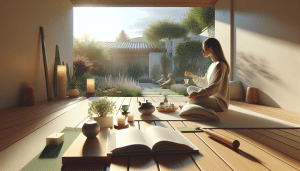Unwinding at Home Entertainment Spaces You’ll Love
Jessica White November 2, 2025
Curious about transforming evenings into memorable experiences? Discover how home entertainment spaces can bring comfort, connection, and variety for everyone. Learn what matters most in setup, tech, ambiance, and quality time—all designed for modern living.
Creating the Ultimate Relaxation Zone at Home
Designing a space dedicated to relaxation and social gatherings is a growing trend in lifestyle and entertainment circles. Homeowners are increasingly prioritizing well-being by setting aside a portion of their living area for casual enjoyment. Whether the plan includes a plush family room, a game nook, or a dedicated media space, the possibilities are nearly endless. The key lies in aligning the design with your interests while making the environment versatile enough to suit guests and everyday use. Home entertainment spaces should feel inviting yet functional, enabling relaxation without sacrificing practicality.
Investing in comfortable, adaptable furniture can make gatherings more inclusive. Sectional sofas, recliners, and modular pieces work brilliantly in creating inviting atmospheres for watching movies, playing games, or simply sharing stories. Flexible lighting—like adjustable lamps or warm LED strips—sets the right ambiance for different moods. Additionally, incorporating elements like soft rugs, cushions, and side tables adds to both the style and comfort. The goal isn’t excess. Instead, it’s about curating an environment where unwinding is effortless and natural.
Many families integrate personal touches by showcasing books, memorabilia, or art that spark conversation and create a sense of belonging. Plants can bring freshness and a soothing vibe while enhancing air quality. For multi-functional spaces, consider movable dividers or curtains that allow the room to switch quickly from a cozy cinema to a vibrant game night hub. The best home entertainment zones blend comfort, personality, and adaptability, reflecting the values and rhythms of those who use them. Creating this oasis isn’t just a luxury—it’s a meaningful lifestyle choice.
Essentials for Home Cinema and Movie Nights
Setting up a home cinema doesn’t always require high-end gear. A quality television or projector, paired with immersive sound, forms the backbone of a remarkable at-home movie experience. The choice between large screens and projectors depends on space and individual preference, but maintaining a good viewing angle for everyone is essential. Comfortable seating, blackout curtains, and nifty storage for streaming devices or remotes complete the practical basics. These small conveniences can turn any living room into a personal theater.
Sound quality often goes overlooked, yet it’s the factor most likely to boost viewing immersion. Surround sound systems or compact soundbars bring audio details to life—think subtle whispering, dynamic musical scores, or deep rumbles. Adjusting speaker positions can maximize acoustic effects, making movie nights truly special. Streaming platforms provide access to countless genres and content, so adding friendly browsing space, such as a tablet or wall-mounted board to note film ideas, makes planning group watch nights simple and inclusive.
Atmosphere is everything for memorable home cinema gatherings. Consider dimmable smart lights for mood transitions or even themed nights with popcorn bars and cozy blankets. Some households install star light projectors or unique LED wall effects for a whimsical touch. Focus on what sparks joy—be it comfortable socks, personal movie marathons, or interactive trivia games in between films. Ultimately, creating a home-centric cinema experience revolves around shared enjoyment and building traditions in comfortable, accessible ways.
Game Nights and Interactive Fun for Every Age
Interactive entertainment options like board games, card decks, or video consoles make home spaces vibrant and dynamic. Game nights bring families or friends together, offering laughter and bonding in an age where screens usually dominate. Curating a collection—be it classics such as chess or modern cooperative games—lets everyone find something they enjoy. Versatile tables, bean bags, or even floor cushions accommodate larger groups and active gameplay without overcrowding the space. Balance is key: the right mix of traditional and digital games creates more inclusive fun.
For tech-savvy households, integrating gaming consoles or VR headsets can elevate immersion. Many prefer organizing themed tournaments or puzzle-solving nights, engaging both competitive and collaborative spirits. Thoughtful storage, like rolling carts or open shelving, keeps supplies accessible but tidy. It’s helpful to plan ahead—snacks, drinks, and scoreboards encourage longer, more enjoyable sessions. Planning a flexible area—where digital play merges with physical activities, like mini tabletop tournaments—cultivates creativity and social connection. Game nights also double as learning opportunities for critical thinking and teamwork.
Interactive gaming doesn’t exclude quieter pursuits. Puzzle corners or reading nooks allow for solitary downtime when desired. Younger guests (or those young at heart) might enjoy arts and crafts, coloring books, or simple DIY kits as alternatives. For groups with mixed interests, ‘choose your own adventure’ setups or rotation-based play let everyone participate at their comfort level. Ultimately, the goal is to nurture spaces that adapt to shifting interests and energies—building memories that outlast any single evening.
Ambiance and Technology: Striking the Right Balance
Combining ambiance with practical technology can revolutionize a home entertainment space. Ambient lighting—whether from string lights, dimmable bulbs, or decorative lanterns—sets the stage for the type of gathering planned. Many hosts experiment with scent diffusers, gentle background music, or even noise-reduction features, creating an immersive sanctuary from daily stress. However, technology should remain an enabler rather than a distraction. Smart home assistants or automated scheduling can coordinate entertainment, from ordering pizza to timing movie intermissions. The secret lies in thoughtful integration.
Screens—both large and small—can sometimes dominate. Artfully disguising televisions (with retractable cabinets or art-like covers) helps strike a visual balance when they’re not in use. Wireless speakers, invisible charging docks, and clutter-free setups reduce visual noise, making the space both dynamic and inviting. Tech can be empowering: voice-controlled playlists set instant mood, while security systems help ensure peace of mind without drawing attention away from relaxation. Choosing which gadgets enhance versus clutter your environment—this is the essence of balance.
Ultimately, ambiance is shaped by what speaks to the individuals inhabiting the space. Personalized background playlists or curated fragrance diffusers define tone. Wall art, striking color accents, or even themed zones—think ‘retro game den’ or ‘modern zen lounge’—can reflect evolving tastes. The ability to adjust, experiment, and refresh the space over time ensures ongoing engagement, comfort, and utility. Technology shouldn’t overshadow connection. Instead, it should quietly support daily unwinding and treasured occasions alike.
Fostering Connection Through Shared Experiences
At their heart, home entertainment spaces are about connection—sharing laughter, stories, or just quiet company. Regular movie marathons, board game challenges, or music jams bring people closer in natural, low-pressure ways. Even solitary pursuits—such as reading or drawing—become richer when a companion shares the same peaceful environment. It’s the rhythm of small traditions, not grand gestures, that builds lasting warmth at home. Flexibility is essential; sometimes, the best moments start spontaneously, unplanned but cherished.
Thoughtful planning lays a foundation for routines you’ll look forward to, but the magic often happens organically. Open invitations, accessible snacks, and activity choices based on everyone’s preferences create a relaxed, welcoming mood. For larger gatherings, collaborative playlists, shared cooking projects, or group crafts inspire new memories. Communication—the willingness to try novel games or share favorite films—broadens perspectives and strengthens bonds. Lifestyle experts agree: connection thrives where comfort and opportunity meet.
Even in small homes or apartments, dedicating modest space for togetherness celebrates what matters. Repurposed corners, balcony lounges, or adapted outdoor patios all support genuine connection. The size of the room isn’t what defines the experience. Rather, it’s the effort invested in making people feel welcome, seen, and part of lasting traditions. Home entertainment zones may shift in style or scope over time. Yet their true purpose—fostering belonging—remains constant.
Adapting Spaces for Modern Lifestyles
Modern households often navigate packed schedules, diverse tastes, and evolving routines. Designing home entertainment areas with versatility at their core reflects this reality. Multi-use furniture, easy-rearrange layouts, and smart storage support everything from solo reading to lively parties. Hybrid spaces—part office by day, entertainment hub by night—help maximize limited square footage. In urban settings especially, conscious design helps combat stress and adds value to everyday life. Entertainment zones can serve as sanctuaries from a busy world.
Environmentally conscious choices are also becoming more prevalent in lifestyle and entertainment spheres. Reclaimed wood furniture, upcycled decor, and energy-efficient lighting add eco-friendly flair. Many opt for sustainably sourced supplies for game or movie nights, such as reusable popcorn bowls or non-toxic art materials. Adding houseplants or small herb gardens integrates nature, improving the mood and air quality of the entertainment area. This mindful approach ensures that enjoyment today doesn’t come at tomorrow’s expense.
Flexibility and inclusivity define successful entertainment spaces today. Whether adapting for accessibility, offering varied seating, or providing screen-free alcoves, the best rooms prioritize the needs of all users. Ongoing feedback from household members or guests guides gradual improvements. As lifestyles shift—be it growing families, new hobbies, or working from home—spaces can evolve without major investment. In this way, home entertainment areas become reflections of growth, harmony, and a thriving modern lifestyle.
References
1. American Society of Interior Designers. (2022). Designing for Wellness: Creating Healthy Home Environments. Retrieved from https://www.asid.org/resources/tools-and-resources/wellness-at-home
2. National Endowment for the Arts. (2023). Creativity and Connection: The Benefits of Arts at Home. Retrieved from https://www.arts.gov/impact/research
3. Harvard Health Publishing. (n.d.). The Benefits of Play for Adults. Retrieved from https://www.health.harvard.edu/blog/the-benefits-of-play-for-adults-2017091512493
4. U.S. Department of Energy. (n.d.). Energy-efficient Home Lighting. Retrieved from https://www.energy.gov/energysaver/lighting-controls/lighting-choices-save-you-money
5. National Institute of Mental Health. (n.d.). Caring for Your Mental Health at Home. Retrieved from https://www.nimh.nih.gov/health/topics/caring-for-your-mental-health
6. Environmental Protection Agency. (n.d.). Indoor Air Quality at Home. Retrieved from https://www.epa.gov/indoor-air-quality-iaq/inside-story-guide-indoor-air-quality








